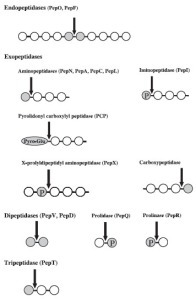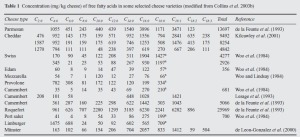The Bloomy Whites
I am, without a doubt, a total cheese junkie. Back when I started making cheese I admittedly went crazy and tried to make too many different types of cheeses all at once, and the results were disastrous. I learned that it’s best to focus on one cheese family, and only once that family has been mastered is it a good idea to switch to another. I chose what I call “The Bloomy Whites” as my major.
Bloomy whites are cheeses that are surface ripened with white mold. Generally speaking, they are usually made with Penicillium candidum (the common name of Penicillium camemberti and Geotrichum candidum [Note: I will refer to these as PC and GC, respectively]. In some parts of France, these and other related molds are in the air. For those of us that are not so lucky, we add them to our milk or spray them on our cheese. So what are these molds and what is it that they’re doing to make these cheeses so delicious?
Once you have drained your curds, you have this enriched mass of fat, protein, and some water. On the inside, bacteria hang out and slowly start to eat the fat and protein. This results in production of fatty acids and flavorful protein fragments called peptides, which include lactotripeptides as well as peptones like tryptone. I’m sure we’ll talk more about that sometime in the future. However, the outer parts of the cheese is where the magic happens.
Once the mold starts growing, it starts to do several things. Like the bacteria, it begins to break down proteins in a process called proteolysis.
Notice that inside the “cell” above, there are lots of proteases listed (endopeptidases, trypeptidases, etc.). There are also proteases in the endogenous bacteria in your milk. This is how cheese from different regions – or even different farms in the same area – can produce cheeses that are distinct from each other. The flavors produced in this process depend on the bacterial composition of the milk and any additive cultures. Amazing!
The proteases break the proteins in the cheese in to peptides and amino acids, which give off lots of flavor.
It also breaks down the curd mass. Depending on the strain of PC that you use, this can result in a completely runny outside or an outside that is slightly soft and wrinkled. Unfortunately, this process produces ammonia as a byproduct (consequently, this increases the pH from acidic to basic at the surface – encouraging more mold growth). This means that if you leave your cheese ripening for too long, or if you let your PC grow out of control at the wrong temperature, you will get a crazy runny rind that slips away from the body of the cheese and a big fat ammonia smell. You can still eat it, but it’s not pretty. GC helps to balance out this process by making the rind thicker, but it also has proteases that break down the curd mass if allowed to overgrow.
PC also breaks down fats in to fatty acids. These are also responsible for a lot of the flavor development in the final cheese.
Again, this depends on the milk that you start with, the length of time the cheese is aged, and the microbial composition of the milk. I think it’s interesting to compare the composition of fatty acids in different types of cheeses:
If you put the whole process together, it looks like this:
There are different concentration gradients for moisture, ammonia, and free fatty acids and peptides. It’s really quite incredible when you start to think about the biochemical processes that are occurring right before your very eyes.
Way back before I started making cheese, I wasn’t sure if you were supposed to eat the rind – and I always cut it off. I can’t believe that I denied myself the rind for so long! You don’t have to eat the rind if you don’t want to, but I consider it an absolutely integral component of these cheeses.
References:
McSweeny, P.L.H. 2004. Biochemistry of Cheese Ripening. International Journal of Dairy Technology 57(2/3):127-144.
Marcellino, N. et al. 2001. Diversity of Geotrichum candidum Strains Isolated from Traditional Cheesemaking Fabrications in France. Applied and Environmental Microbiology 67(10):4752-4759.





One Reply to “The Bloomy Whites”